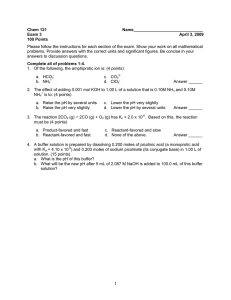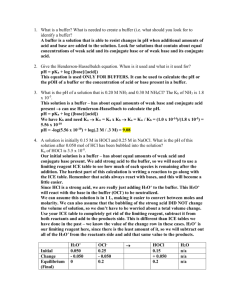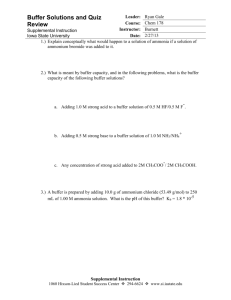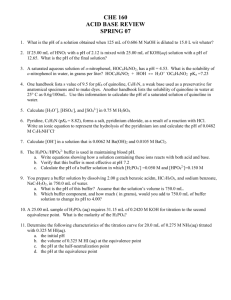PHOSPHATE BUFFER SYSTEMS Experiment 44
advertisement
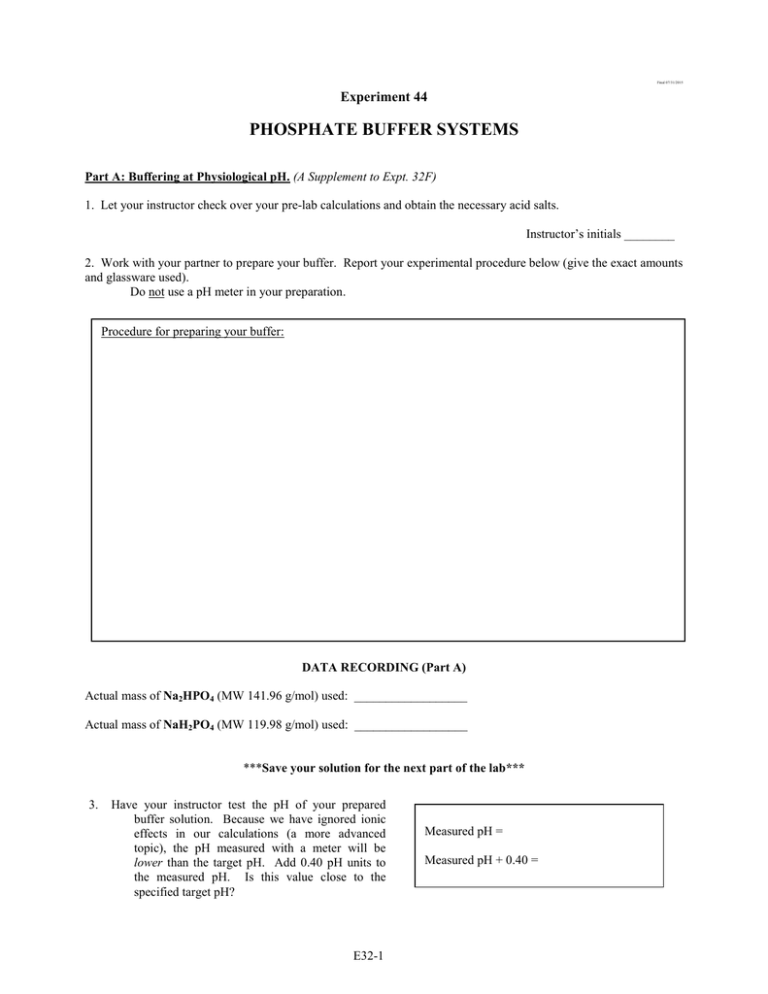
Final 07/31/2015 Experiment 44 PHOSPHATE BUFFER SYSTEMS Part A: Buffering at Physiological pH. (A Supplement to Expt. 32F) 1. Let your instructor check over your pre-lab calculations and obtain the necessary acid salts. Instructor’s initials ________ 2. Work with your partner to prepare your buffer. Report your experimental procedure below (give the exact amounts and glassware used). Do not use a pH meter in your preparation. Procedure for preparing your buffer: DATA RECORDING (Part A) Actual mass of Na2HPO4 (MW 141.96 g/mol) used: __________________ Actual mass of NaH2PO4 (MW 119.98 g/mol) used: __________________ ***Save your solution for the next part of the lab*** 3. Have your instructor test the pH of your prepared buffer solution. Because we have ignored ionic effects in our calculations (a more advanced topic), the pH measured with a meter will be lower than the target pH. Add 0.40 pH units to the measured pH. Is this value close to the specified target pH? E32-1 Measured pH = Measured pH + 0.40 = Scenario: Your group is made up of sailors on a submarine that is on a secret mission. The doctor on the submarine went into cardiac arrest and he now has acute acidosis (which means his blood pH is too low). The pH of normal, healthy blood is approximately 7.40. Your submarine cannot surface to transfer him to a medical facility because your secret mission would be compromised. Since he’s the doctor, you’ll need to save him without any professional help. You must rely on your SC112 knowledge of buffers. Supplies on the submarine are limited and the only available pH meter is broken! Procedure: Assume the buffer that you designed and prepared in step 3 above is the blood of the doctor after his cardiac arrest. Your job is to decide how you are going to raise the pH of this “blood” sample to a normal pH level. After you are confident in your calculations, carry out your pH raising procedure on the “blood” sample. Do not use the pH meter. Record your calculations and procedure below. Hint: If you need to add small amounts of some solution, consider using a small plastic dropper. You may need to calibrate the dropper so you know how many milliliters are contained in one drop. Other pipets are also available. Calculations: Procedure: Bring the sample to your instructor to measure its pH and find out if you saved the doctor! Remember to correct for ionic effects. Measured pH = Did you save the doctor? Measured pH + 0.40 = Note: The most important buffer system in blood is the carbonic acid/hydrogen carbonate system: H2CO3 (aq) + H2O (l) H3O+ (aq) + HCO3- (aq) The ratio of [HCO3-]:[H2CO3] is about 10:1 in blood because there are more acidic than basic byproducts of metabolism that the blood buffer has to accommodate. When a patient is in cardiac arrest, there is not time to perform a titration of the blood to raise its pH. Instead, a reasonable amount of HCO3- (NOT NaOH) is administered and then the doctors check to see if that treatment worked, or if more HCO3- must be given to the patient. E32-2 Part B. An Acid-Base Titration of Boiler Water. (A Supplement to Expt. 14) 1. Your instructor will demonstrate the use of the pH meter, including standardizing the meter and taking measurements of pH. Make any notes for future reference. 2. Rinse and fill a 50-mL buret with 0.010 M HNO3 solution. 3. Use a graduated cylinder to obtain a 100.0 mL sample of boiler water, and place the sample in a 400mL beaker. Place the beaker on a magnetic stirrer and add the clean, dry stir bar. Place the pH meter probe in the boiler water sample; set the height within the solution to ensure that the stir bar will not hit the probe during use. Install the buret with your 0.010 M HNO 3 solution in place for a titration. 4. Add 2 drops of phenolphthalein indicator solution to the boiler water sample. Start the stirrer and begin the titration. Record your data on the next page, taking pH readings and noting the color at approximately 0.5 mL intervals (or smaller if the pH is changing rapidly). The pH reading may drift somewhat, but you should only wait a few seconds after each addition before taking a pH reading. Immediately after the first color change, add 2 drops of methyl purple indicator solution and continue the titration, recording pH and color until you have added a total of about 40 mL of titrant. E32-3 DATA RECORDING (Part B) Record Volume of 0.010 M HNO3 added, pH and color changes on this page. DATA ANALYSIS (Part B) Use Excel to produce a clearly labeled pH vs. volume HNO 3 plot of your titration curve. Indicate (a) the equivalence points and (b) the pH ranges of the various colors observed. E32-4 Name ________________________________________________ Section _______ Date _________ PRE-LAB (Relates to Part A) Calculate the mass of Na2HPO4 (MW 141.96 g/mol) and NaH2PO4 (MW 119.98 g/mol) needed to prepare 50 mL of a buffer in which the total buffer concentration (i.e., [weak acid] + [conjugate base]) is 0.100 M and of the pH specified by your instructor. (You will be preparing the buffer you design in lab) Make sure to select the appropriate Ka value for this buffer system. H3PO4 (aq) + H2O (l) H2PO4− (aq) + H2O (l) HPO42− (aq) + H2O (l) H3O + (aq) + H2PO4− (aq) H3O + (aq) + HPO42− (aq) H3O + (aq) + PO43− (aq) pKa1 = 2.12 pKa2 = 7.21 pKa3 = 12.38 Refer to Post-Lab question 6 of Experiment 32 if needed. Show your calculations below. Buffer # ____________ Specified target pH = _______________________ Calculations: E32-5



